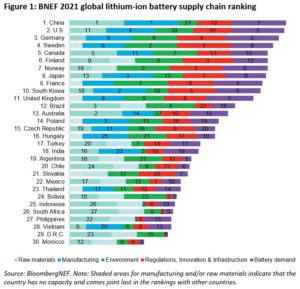US narrows gap with China in race to dominate battery supply chain – report
“As a country, the US has the second-largest EV market globally, after China. Tesla and Asian cell manufacturers continue to make significant investments in the country, and the Biden administration’s policy to help establish a domestic battery supply chain and support EV growth will further strengthen the country’s position,” the report reads.
In the view of BNEF’s experts, America has many of the ingredients needed to foster a domestic lithium-ion battery value chain but in the past, individual companies like Tesla have had to forge a path by themselves. Now that there is policy support in place, however, there seems to be a coordinated effort from companies across the supply chain to anchor more value within the country.
But even as the US makes considerable strides to build and strengthen its domestic battery supply chain, China continues to dominate the ranking throughout the period thanks to continued investment and strong local and global demand for its lithium-ion batteries.
BNEF’s data show that China hosts 80% of all battery cell manufacturing capacity today, with capacity expected to more than double to over two terawatt-hours, enough capacity for more than 20 million electric vehicles in the next five years. Yet, as governments around the world recognize the strategic importance of the battery industry, local supply chains are emerging to challenge China’s dominance.
Europe also dominates
BloombergNEF’s research also shows that European countries are rising up the ranking as passenger EV sales steadily grow, attracting more investment in the supply chain.
Nordic countries seem to be leading the way as their low-carbon power supplies make them attractive to environmentally conscious companies.
“Finland will soon be home to one of the world’s largest refineries for nickel and cobalt sulphate, both key ingredients for use in EV batteries. Battery material producers Umicore and BASF have also both invested in the country,” the review states. “Later in 2021, batteries are expected to roll off the production line from the first European-owned gigawatt-hour scale cell plant, when Northvolt commissions its Swedish facility.”
The document notes that even though European countries are ranked individually, the ability for tariff-free trade between countries in Europe means that, as a continent, its battery demand is second only to China. At the same time, if ranking Europe as a whole, it comes first in the supply chain ranking in 2021 and 2026.

“Europe has set the ambitious goal of supplying all of its own battery demand for the region by 2025 and has committed billions of euros in state aid to attract investments in the battery supply chain. We are now starting to see the results of this effort,” Cecilia L’Ecluse, energy storage analyst at BNEF, writes in the report.
Individually, Finland has managed to move up the rankings, which is unusual given that most resource-rich countries tend to rank lower in the supply chain ranking as they generally lack a domestic battery supply chain and battery demand.
Other important players
Similar to Finland, Australia – considered to be the largest lithium producer by metric tonnes – has managed to move up the ranking by leveraging its metals supply to attract more investments into its domestic battery industry.
BNEF’s analysts see a similar pattern in Indonesia, a country that is shifting its focus downstream to become a key player in the global battery value chain, and Canada, which is looking to provide a greener alternative for battery metals supply.
South Korea and Japan, on the other hand, rank lower in 2021 compared to last year, but Japan is on track to rise up through the ranking to take third place in 2026, as domestic demand increases alongside continued investments in materials refining and component production.
“However, Japan and South Korea’s environmental scores continue to hold them back, a result of the high carbon intensity of their power grids,” the review states. “While not everyone values sustainability when it comes to lithium-ion battery manufacturing, automakers have increasingly high standards for the carbon footprint of battery cells.”




